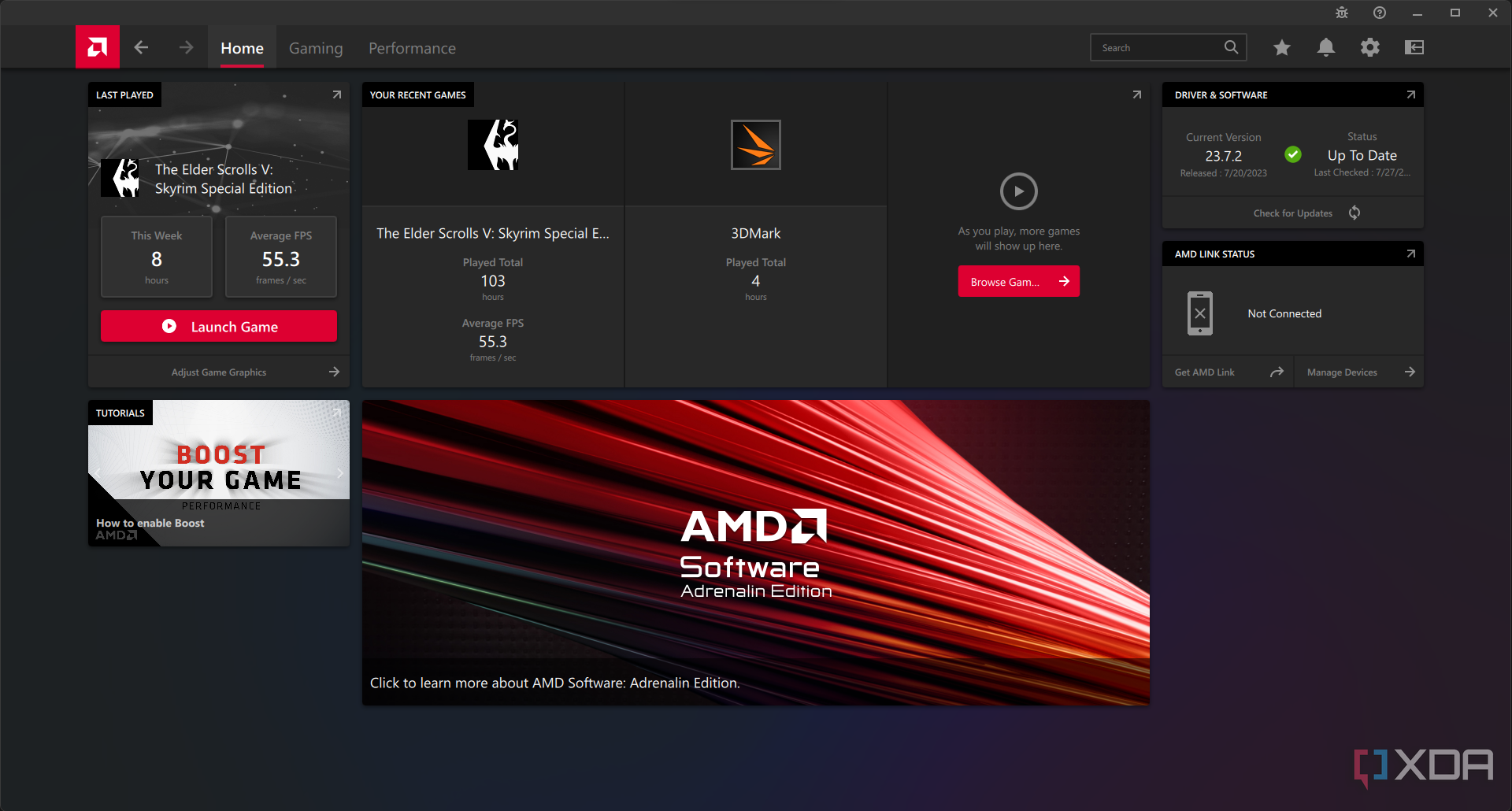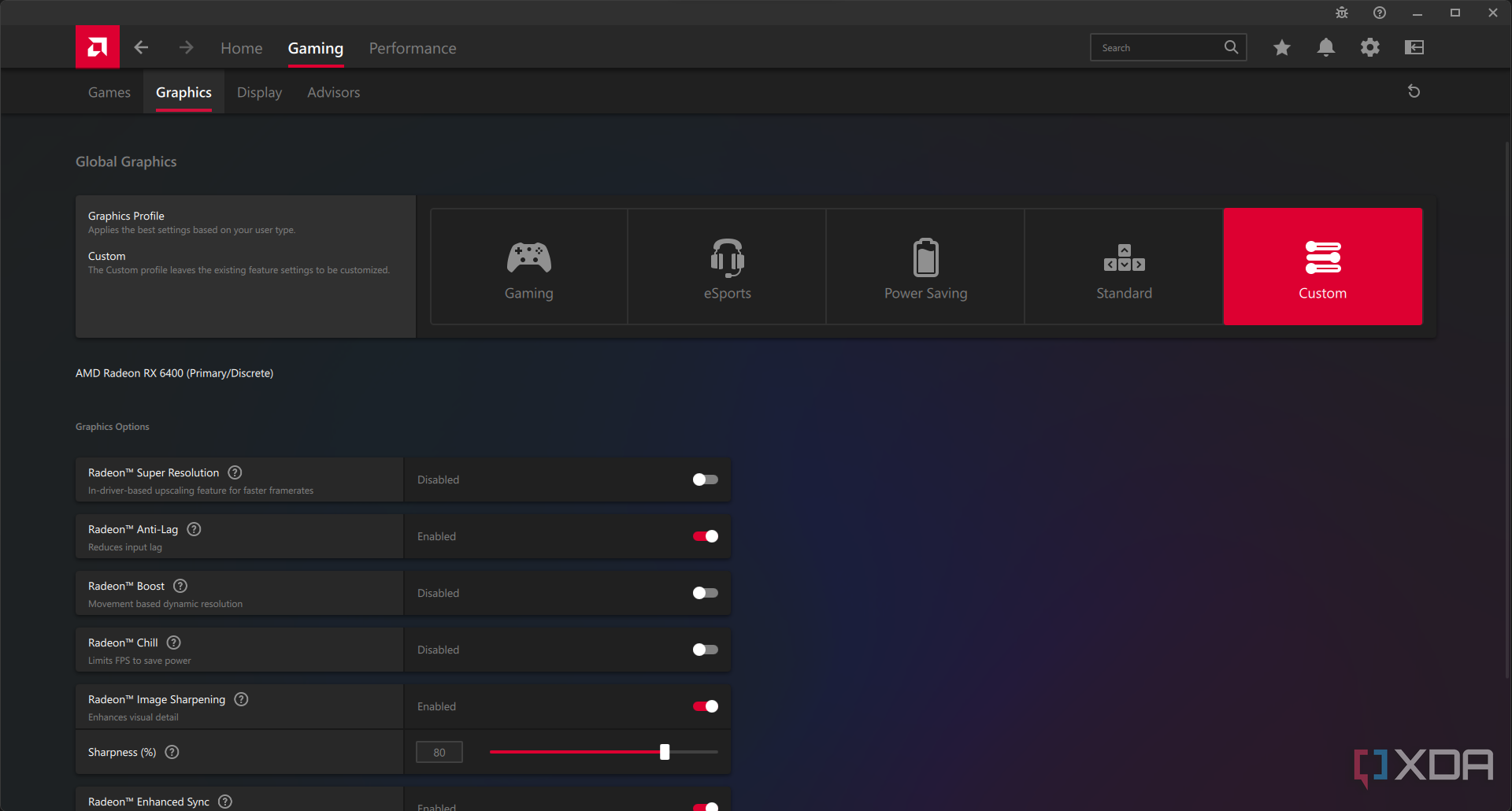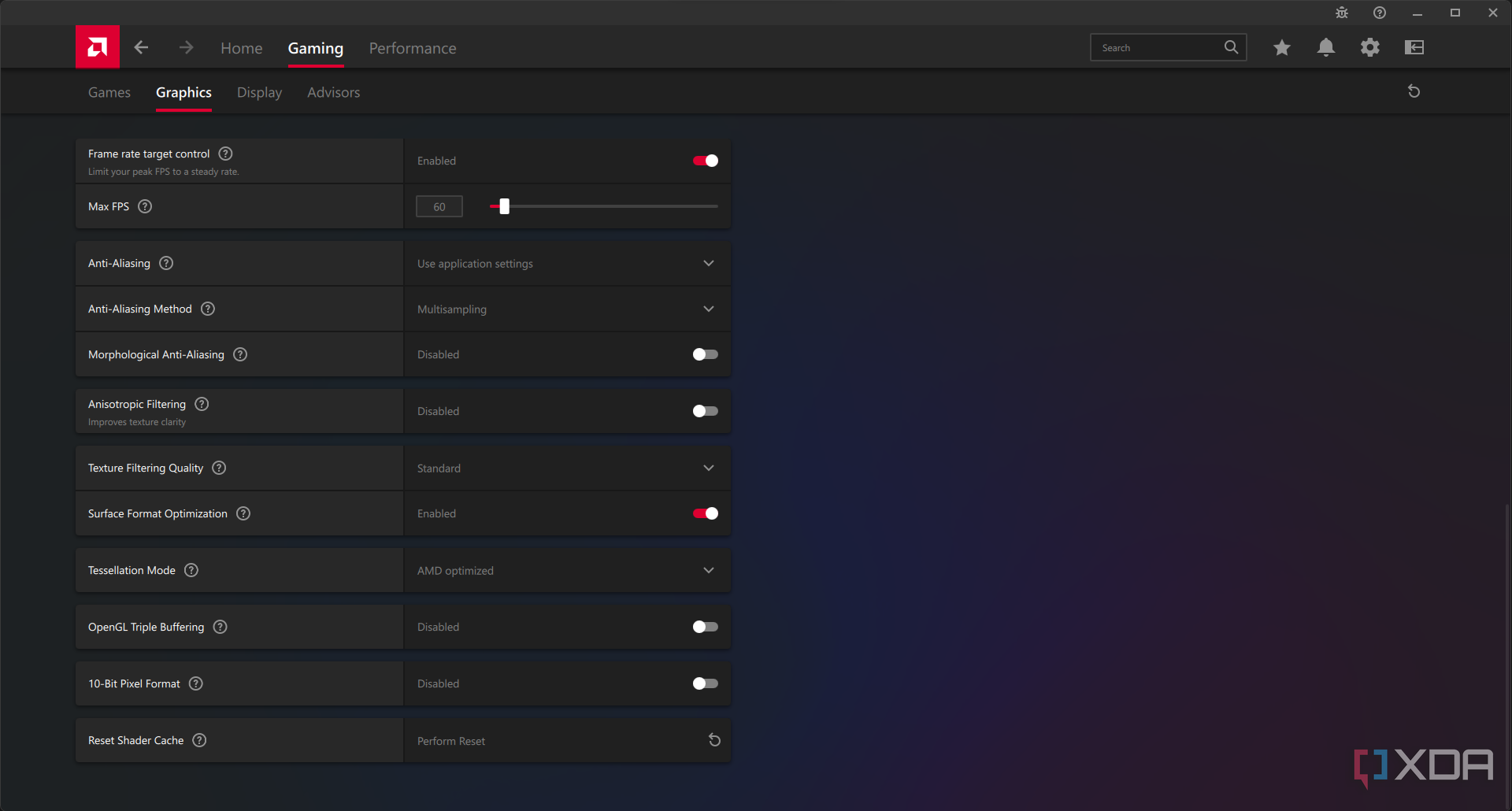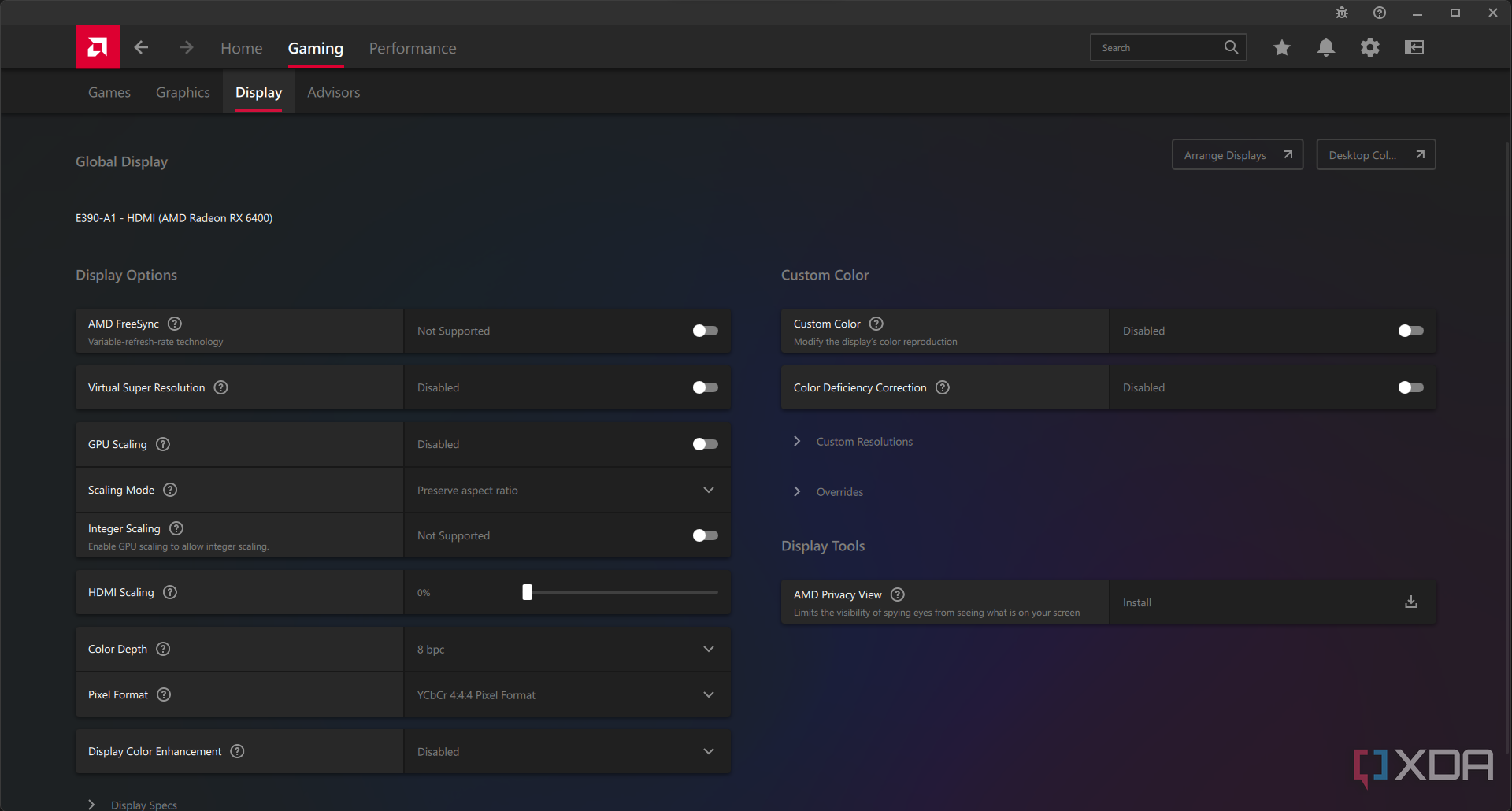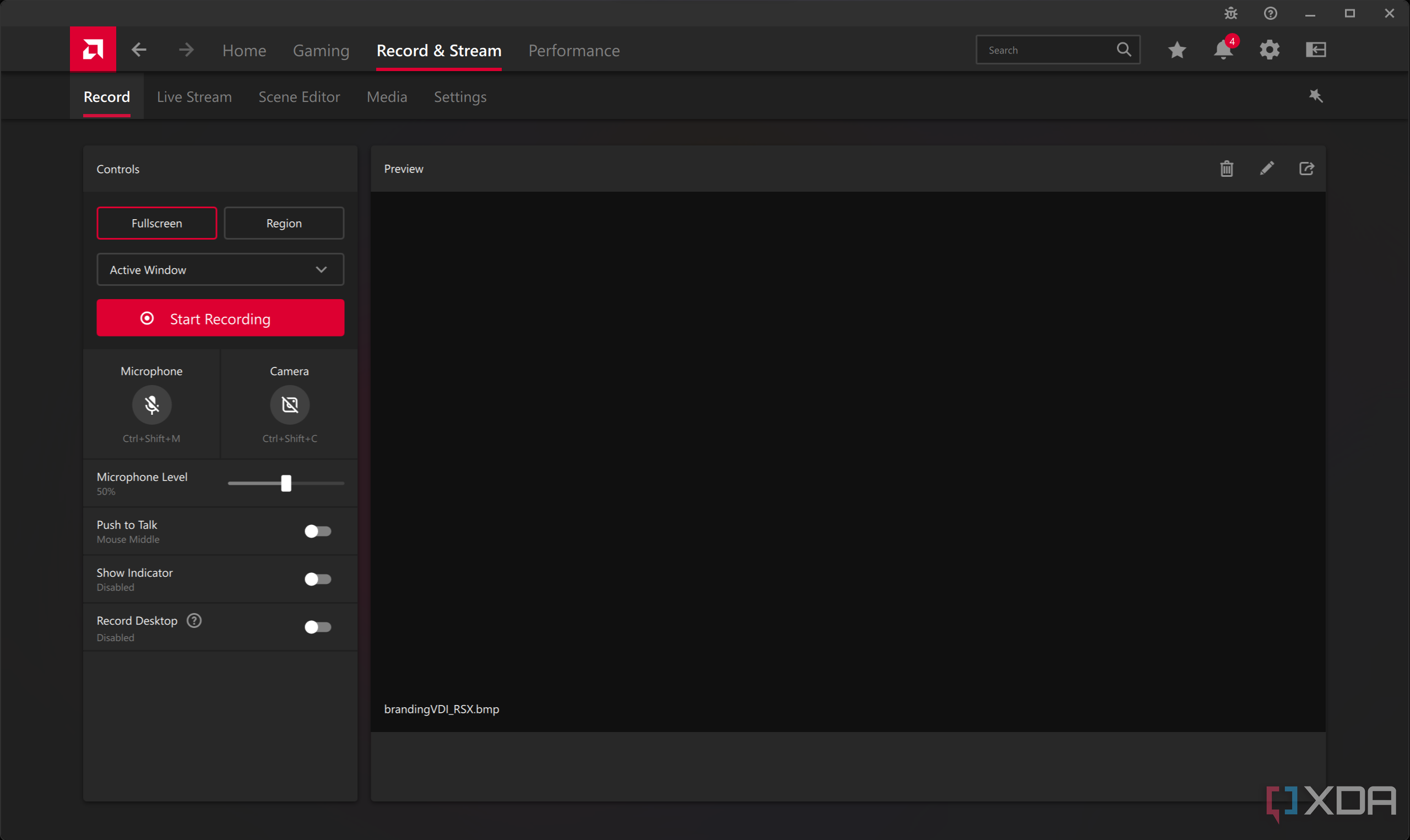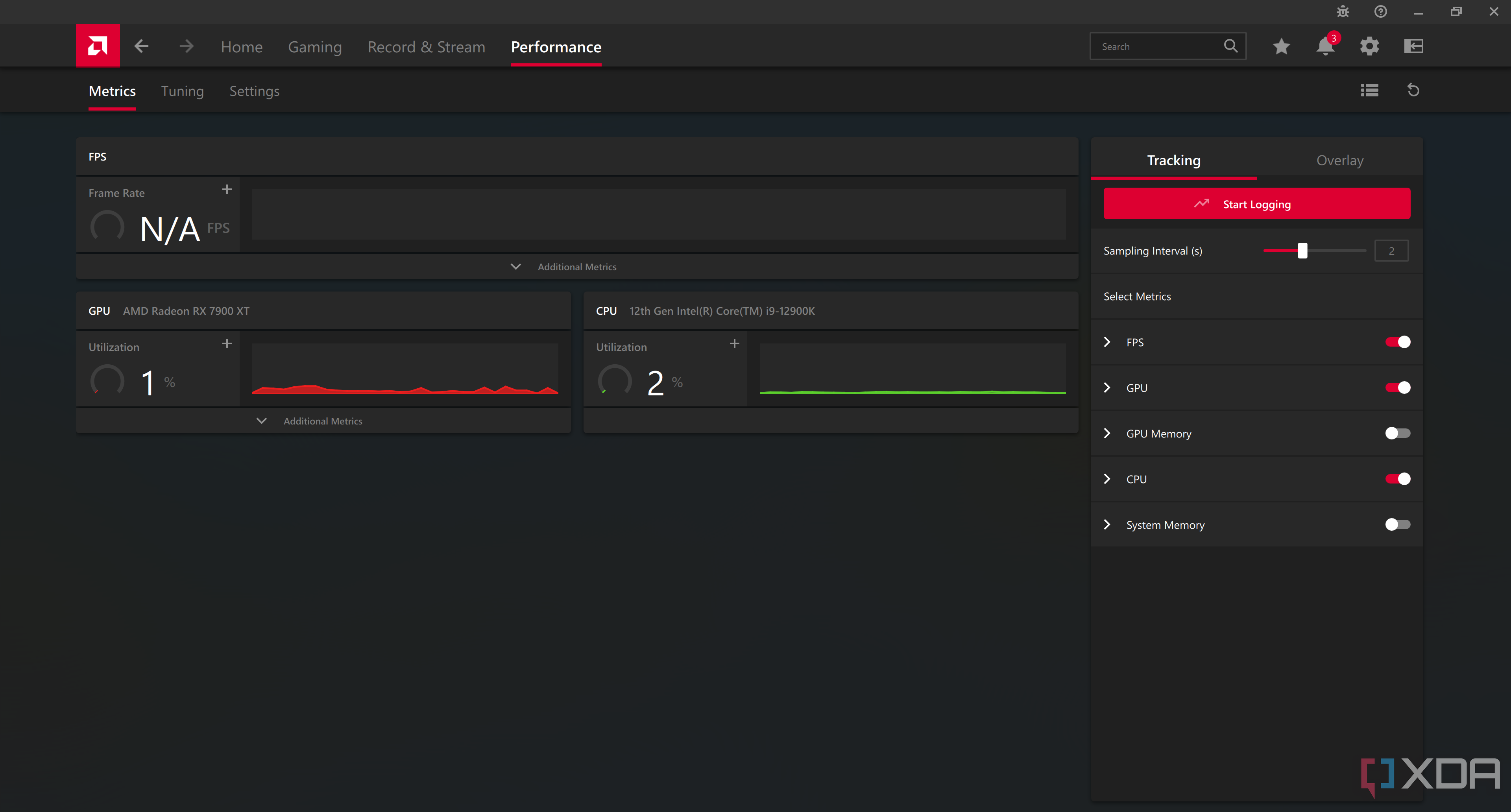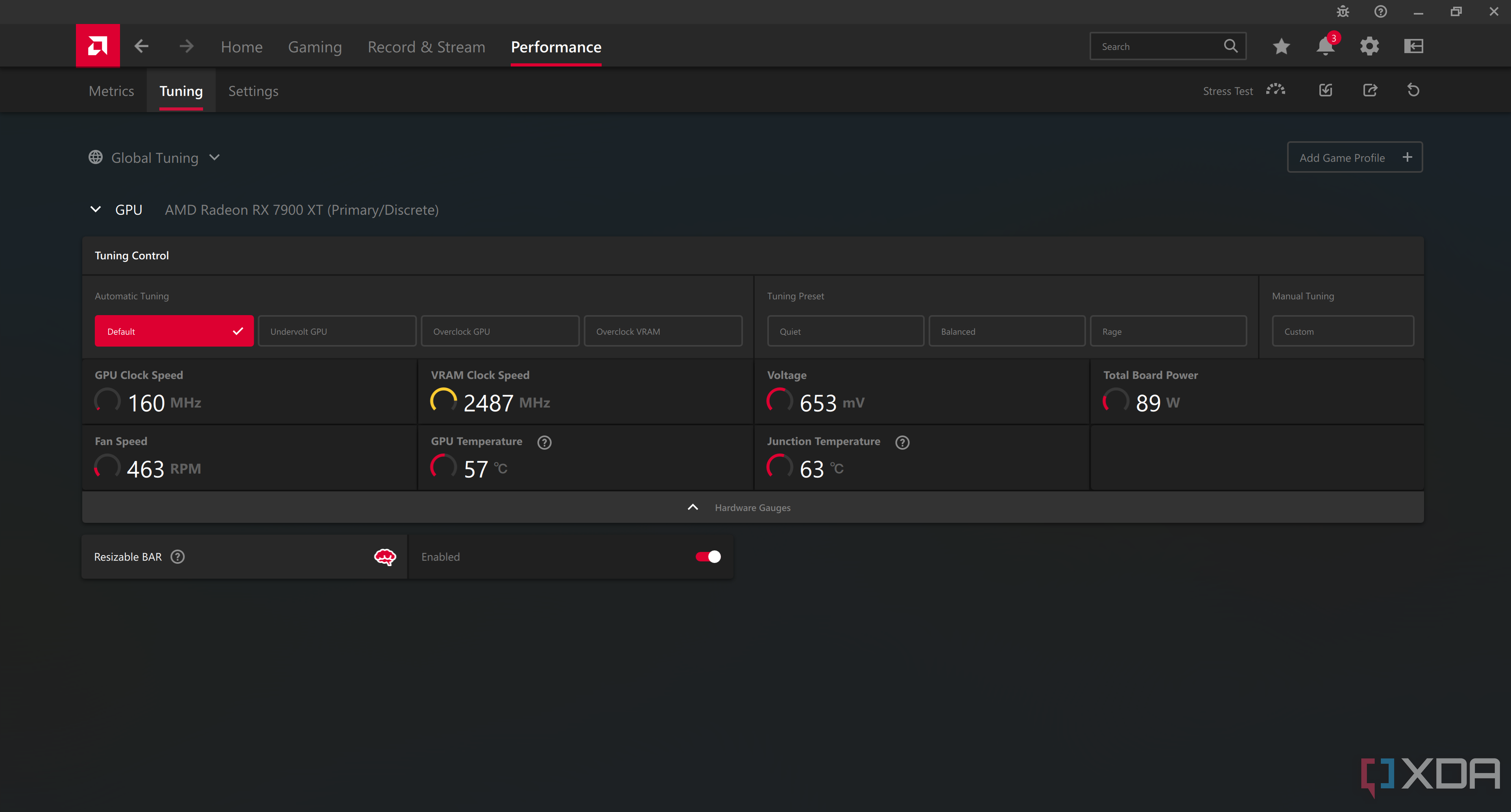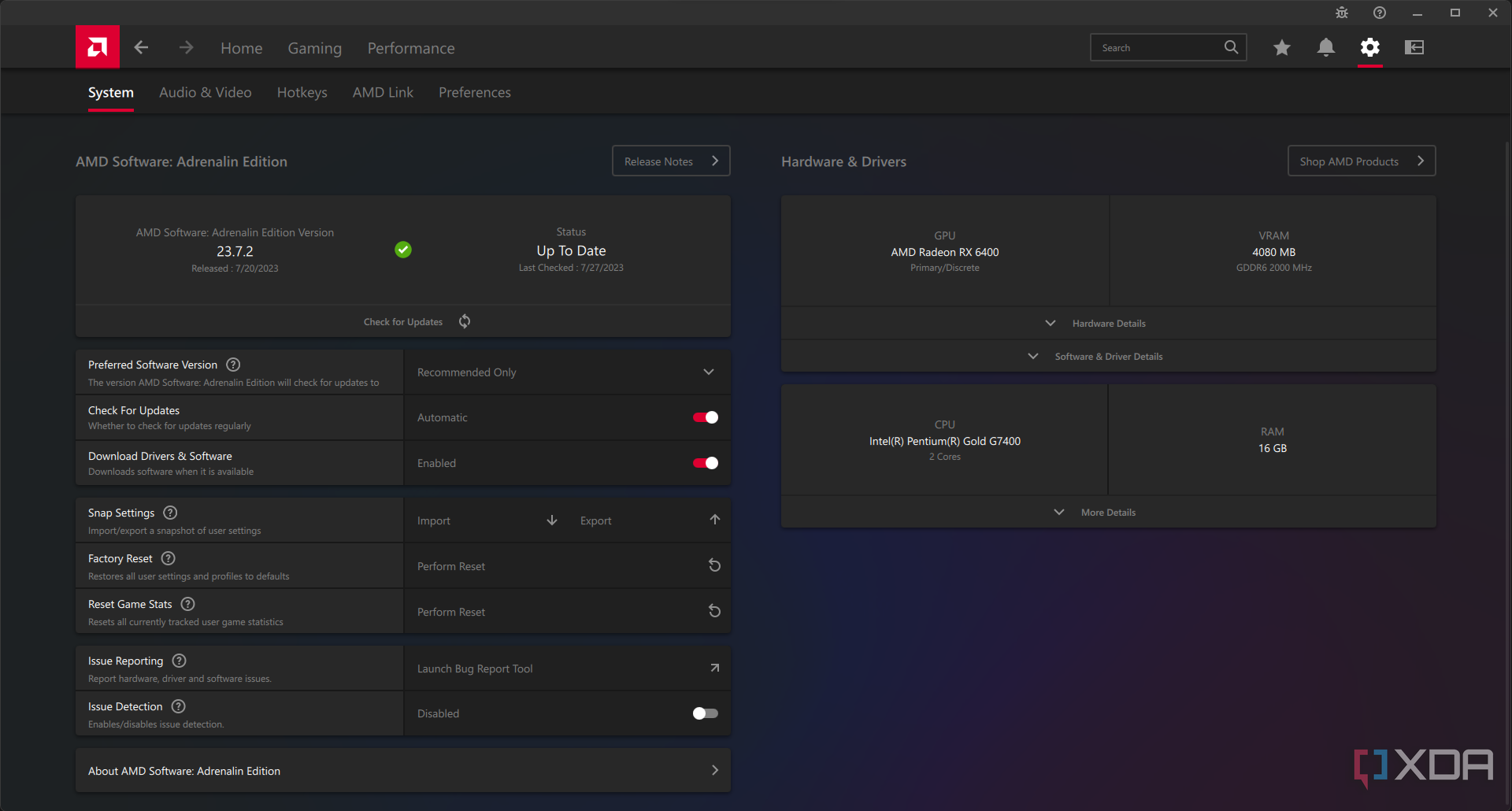For several years now, AMD has put lots of emphasis on the software it packages with its GPUs, which rank pretty high among the best GPUs you can buy today, and today it’s safe to say that its AMD Software Adrenaline Edition is really well-developed (even if the drivers themselves aren’t always super optimized). There’s lots you can do in AMD Software, and I’m going to guide you through everything it has to offer, and point out stuff that you might be interested in.
AMD Software overview
Radeon Software is organized into five distinct sections: the Home tab, the Gaming tab, the Record & Stream tab (if you have supported hardware), the Performance tab, and a general settings section (symbolized by the gear icon near the top right corner) and these are generally divided into other subsections. To start off with, here’s a brief summary of each of these tabs.
- The Home tab is what you see when you open up Radeon Software. Here you can see some of the latest games you played, your driver version, whether AMD Link is connected or not, and some ads and tutorials. In general, there’s not much here and it’s mostly just a gateway to the other tabs.
- The Gaming tab contains everything about games and graphics settings, and has four of its own smaller tabs: Games, Graphics, Display, and Advisors. There’s lots to do here and I’ll break it all down in a bit.
- The Record & Stream tab is where you can access Radeon ReLive, which allows you to record and stream gameplay underr four secondary tabs: Record, Live Stream, Scene Editor, and Media. If you’re at all familiar with Nvidia Shadowplay, then Radeon ReLive should be pretty familiar since it covers the same functions. Please note that some AMD GPUs (like the RX 6400 and many if not all APUs and mobile GPUs) don’t support Radeon ReLive, so this tab might be missing on your machine.
- The Performance tab is where you can find all the overclocking and performance overlap options. This tab has three tabs of its own: Metrics, Tuning, and Settings. I’ll also explore this tab in depth.
- The settings tab contains a spread of options that don’t really fit anywhere else, like driver update stuff, audio settings, hotkeys, and more.
The Gaming tab
The Gaming tab is easily the most important of the five sections in Radeon Software simply because it contains lots of settings you might want to tweak. Lots of AMD’s killer software features are contained in this area, and I’ll break down each of the secondary tabs here.
The Games tab is not a super important one; it shows you all the games on your PC, how many hours you’ve played in them, and your average framerate over the course of your playtime. Clicking on these profiles will bring up another screen that allows you to launch the game from Radeon Software and even set up custom graphics options just for individual games.
Speaking of those graphics options, the Graphics tab is where you change those graphics options (in this specific submenu, the settings are applied to all games; you can change these settings for individual games by clicking on their icons in the Games tab), and there are quite a few things you can tweak here. AMD has some graphics presets here and while you may choose to use them, I’d recommend sticking with the Standard preset and changing some of these settings on your own. Here’s a quick rundown of the settings you’ll probably be interested in:
- Radeon Super Resolution allows you to set a higher resolution than your monitor can output as a form of brute force anti-aliasing. Not the most graphically efficient way to make games look better, but it is an option.
- Radeon Anti-Lag reduces input lag, and it’s really useful pretty much all the time, especially if you’re playing any sort of competitive games where less latency is useful for getting the win.
- Radeon Boost dynamically changes the resolution depending on your movement in games, which in theory improves performance without ruining graphically fidelity. This feature, however, only works in a handful of titles.
- Radeon Chill dynamically lowers the power consumption of your GPU according to how much you’re engaging with a game (idling will result in low power, moving around all the time will mean max power). Like Boost though, Chill is only supported in select titles.
- Radeon Image Sharpening is a simple image sharpening filter that works across all games but doesn’t do nearly as much as features like DLSS or FSR. You can try fiddling around with it to see if it improves your gaming experience.
- Radeon Enhanced Sync is a software-based anti-screen tearing technology that is supposed to work pretty much just like FreeSync if your monitor doesn’t support it. It’s not perfect but it’s worth enabling if you don’t want to see screen tears.
By the way, many of these settings are mutually exclusive; you can only choose one of Anti-Lag, Boost, and Chill to be enabled at any one time. AMD’s HYPR-RX feature however allows you to enable Super Resolution, Anti-Lag, and Boost at the same time, but at the time of writing it is not yet out, though it probably will be pretty soon.
There are a bunch of other graphics settings under this Advanced submenu that’s hidden by default, but most of these settings are legacy options that don’t do anything anymore. The Frame rate target control option is the only one here I’d consider useful as it lets you set a max FPS within the drivers itself.
The Display tab has some important settings like enabling AMD FreeSync, which you should definitely do if your monitor supports it. You can also set up a custom desktop resolution if you desire, change GPU scaling options, and color options. You probably don’t need to change anything here except maybe FreeSync.
Finally, the Advisors tab is pretty useless. It’s just an area that tells you how well your games are running and what you can do to make them run better, but honestly I would recommend tweaking games on your own instead of trusting AMD’s app to tell you what to do. There are lots of performance guides for all sorts of games out there that’ll help you figure out what settings you should probably disable.
The Record & Stream tab
Under the Record & Stream tab is where you’ll find all the recording, streaming, and media functionality formerly known as Radeon ReLive. This tab won’t show up on certain hardware, like low-end GPUs such as the RX 6400 and APUs like the Ryzen 5 5600G. Here’s a quick breakdown of each tab in this section:
- The Record tab is where you’ll find a basic recording app with a preview, resolution and monitor options, and mic and camera options.
- The Live Stream tab contains a basic live-streaming program, similar to the Record tab except with some extra stream specific tools like scenes and a chat window.
- The Scene Editor tab is where you can edit scenes for your streams
- The Media tab contains all the videos, streams, and screenshots you’ve taken with Radeon Software.
- The Settings tab contains lots of recording and streaming settings, the sort of which you’d find in apps like OBS, such as the recording resolution, recording framerate, bit rate, and stream keys.
The Performance tab
If you’re interested in benchmarking and overclocking, the Performance tab is an area you’re likely to care about since it hosts AMD’s built-in performance overlay as well as all the nitty-gritty overclocking settings, as well as some automatic overclocking tools.
Starting off with the Metrics secondary tab, this is where you can see performance metrics like FPS, GPU utlization, CPU utilization, and so on. You can enable and disable certain metrics that you may find more or less useful, change the sampling interval (basically how long it takes for the info to update), from every second to every five seconds, and where the overlay appears on the screen (if you have a mobile GPU, you may not be able to use the performance overlay). You can also log your performance data, making AMD Software a benchmarking tool in its own right.
The Tuning tab contains all of the GPU overclocking settings, formerly known as Wattman. While AMD allows you to customize clock speed, voltage, and other settings just like MSI Afterburner or other tools would, AMD also includes several automatic and preset options that might save you some time. However, not all AMD GPUs support these features, including APUs, mobile GPUs, and some desktop GPUs like the RX 6400.
Overclock GPU and Overclock VRAM are pretty self-explanatory, but then there’s the Undervolt GPU button, which tries to lower the voltage without lowering clock speed, allowing for more efficient operation. There’s also some noise based presets: Quiet, Balanced, and Rage. These presents essentially range from least noisy and least performant to most noisy and most performant.
There are also a couple other things here. At the top right, there’s a button that says Stress Test, and this basically runs a heavy workload on your GPU to see if it’s stable. Personally, I prefer to run stuff like 3DMark instead of using built-in tests just to be extra certain. There’s also a lone option here called Resizable BAR, and if your PC supports it, you should definitely enable it since it can improve performance in some games. Even if you have a locked GPU, you should still be able to enable this setting, assuming your hardware otherwise supports resizable BAR.
Finally, we have the Settings tab, but at the time of writing it just contains settings pertaining to the Metrics tab: changing the sampling interval, enabling and disabling the performance overlay, choosing where to store the performance logs, and whether to hide the performance overlay while logging.
General settings
The gear icon in the top-right is where you’ll find a general settings menu with an assortment of random options. It’s further divided into five tabs, and I’ll quickly run these down for you.
- The System tab contains options for updating drivers, importing and exporting settings, resetting the software to defaults, bug reporting, and basic info about your system, like what driver it’s running, what GPU it has, and so on.
- The Audio & Video tab is where you can enable AMD Noise Suppression, which cleans up your input audio just like RTX Voice, and also does it for your output sound too. It’s supported on RX 6000 GPUs and newer, as well as Ryzen 6000 APUs and newer (though it’s not clear if Ryzen 7000 APUs that use older hardware from previous generations will also work).
- The Hotkeys tab is where you can view and edit hotkeys for things like pulling up the Radeon overlay, enabling and disabling stuff like Boost and Chill, and even rotating the display.
- The AMD Link tab is where you can connect your PC to your phone via AMD Link, which is an app that allows you to stream games to your phone and also view the performance metrics on your phone.
- The Preferences tab just has a bunch of options like whether you want the Radeon overlay on or off, if you want ads on the Home tab, what language you want, and some other minor stuff.
That’s pretty much it for the general settings menu. It used to contain lots of options like the graphics and recording/streaming settings, but recently AMD moved all that to the Gaming and Record & Stream tabs, which are more suited for those kinds of settings.
One of the few distinct advantages AMD has over Nvidia
If you own an Nvidia GPU or have ever looked at our Nvidia software guide, you’ll know how much of a mess it is. The main driver app hasn’t been substantially updated in over a decade, lots of options are pretty useless because they’re old, and you need to install other Nvidia programs like GeForce Experience and Nvidia Broadcast to achieve the same level of functionality that AMD provides in one app. By contrast, AMD Software is modern, performs well, and is generally useful, which are usually the words you’d use to describe Nvidia.
While AMD GPUs aren’t perfect, you can at least rest easy knowing AMD takes good care of its custom software and updates it somewhat regularly to add new features or just to make it look and run better. It’s really nice to see AMD give so much care and attention to an important thing that most users probably don’t even use much if at all.
[ad_2]


